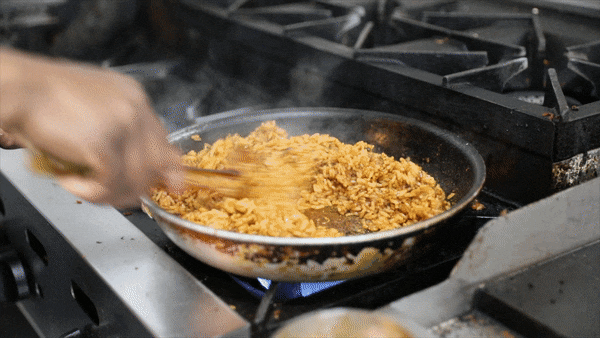Get a 'good kick' from the spices and sauces at this Afro-Asian spot
Get Grill is located at 7910 Hurontario St. in Brampton

Nigerian chef Tayo Adedayo aka Bab T. started his career as a spice master before he opened his restaurant in Brampton, called Get Grill, with his wife Tobi Adedayo.
"The first chapter of my cooking career was in creating sauces and spices," he told me.
"I am a grill man, so I learned how to make marinades and things that go on meats and vegetables," he said as he took me on a tour through the kitchen, revealing mason jars and spice containers of his current experiments.
"Try sprinkling this on the orisirisi; it will give it a good kick," he said as he spread the bright orange, dry seasoning on one of the best things to eat at Get Grill, a plate of stir fried organ meats.
At his restaurant, Bab T. makes no less than a half a dozen spice blends — they're available for sale — and a secret lineup of marinades and hot sauces that you have to ask for.

Unusual? Not anymore in this town.
In the last decade, we've become obsessed with hot sauces and spice blends, and I'm not referring to the imported store-bought chili sauce and packets of ambiguously labelled spice blends from the Far East.
Nowadays, cooks are often using something that is crafted in-house and is fresh and pungent, having learned that diners are handling more fire and spice, and we have access to a plethora of peppers from around the world.
Also, manufacturing and selling small-batch hot sauces can be a feasible entry point into the restaurant industry, especially for small-time entrepreneurs and newcomers.
People bring their food cultures from around the world. They bottle the very essence of it in jars and if they're lucky they'll find a farmer's market or two and set up a pop-up stand to sell hot sauces accompanied by one or two dishes. That's what Bab T and his wife Tobi did.
"It allowed us to eventually open our first restaurant in Brampton in 2011," Bab T. said.

Bab T. calls Get Grill a fusion restaurant, where he's pulling in dishes from his Nigerian heritage and leaving the doors open for experimentation.
"For example, we have some dishes that I would think are Afro-Asian fusion. The spice and depth from African flavours and some sweet elements I borrowed from Asian cooking."
The experimentation has produced some unique dishes. One example is the suya beef jambalaya jollof rice. It's a dish that keeps me coming back.
Bab T. says it is also a dish in which "Africa is reunited with the food culture of the American south."
Suya is a Nigerian street-food delicacy where fatty beef is grilled on high heat before getting smothered in a blend of spices.

Bab T's version tastes different than any other I've tried but that I can attribute to his sauces and spices. There's a pronounced peanut flavour with the meat, and Bab T. uses sirloin cuts of beef so the beef is very tender when it is served.
For the rice that accompanies the beef suya, Bab T. borrows from the deep flavours of jambalaya and marries it with tomato and chili popper found in traditional jollof rice. The consistency is somewhat akin to a paella with layers of notes in each spoonful.
You'll detect a slight sweetness, coarse pepper and notes of smoke. This symphony is achieved with spices and blends. The rice is cooked with a thick spice paste, which imparts the colour and "the flavours of West Africa" as Bab T. likes to say.
You can enjoy the jollof version of the rice on its own if you prefer. Bab T. serves it in a number of ways, including with grilled salmon or vegetables cooked in a sweet-and-sour sauce.

Back to the orisirisi.
"This is a dish that is not for the faint of hearts but it is the most West African dish we do."
Picture morsels of liver, kidneys, tripe, gizzard cooked on high heat with a custom blend of sauces. Ehuru, also known as African nutmeg, is a key component of the dish.
It is a dance of textures and something you have to try if you visit Bab T's restaurant.


